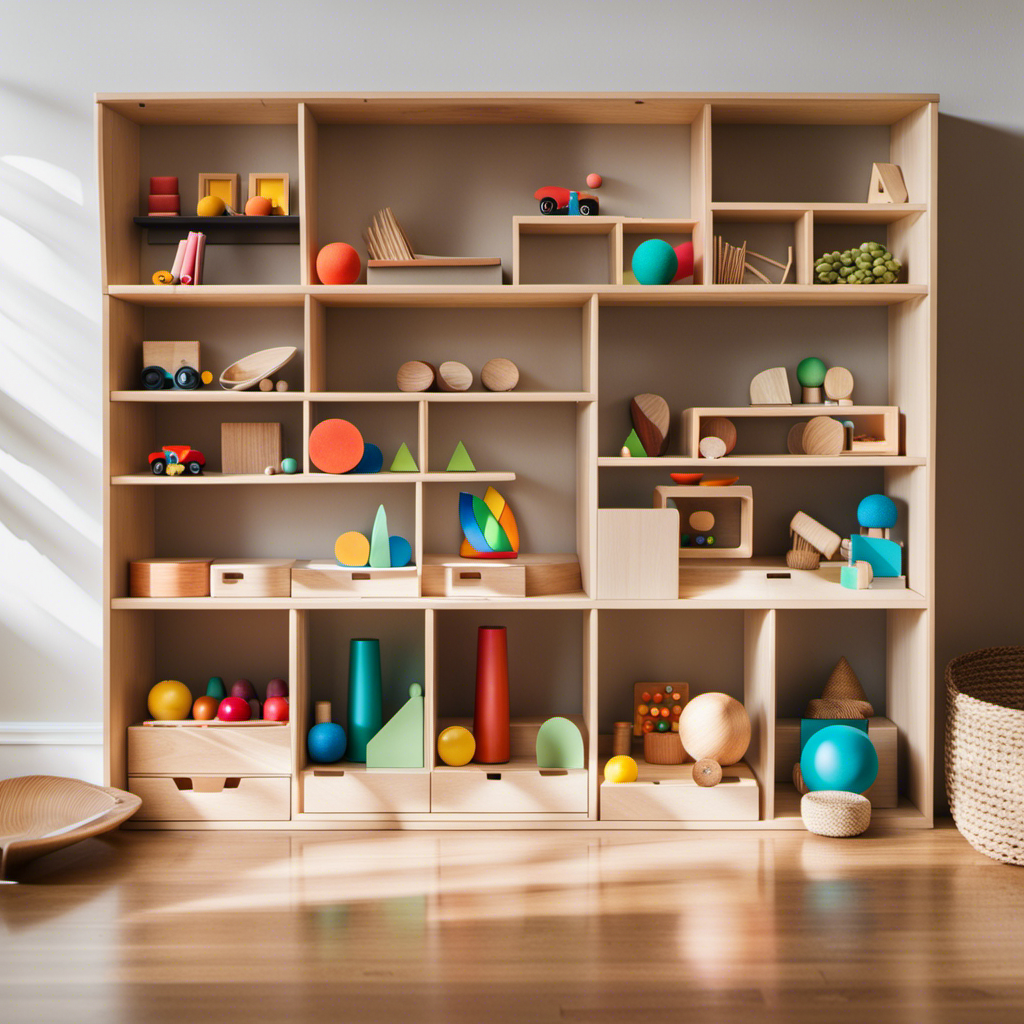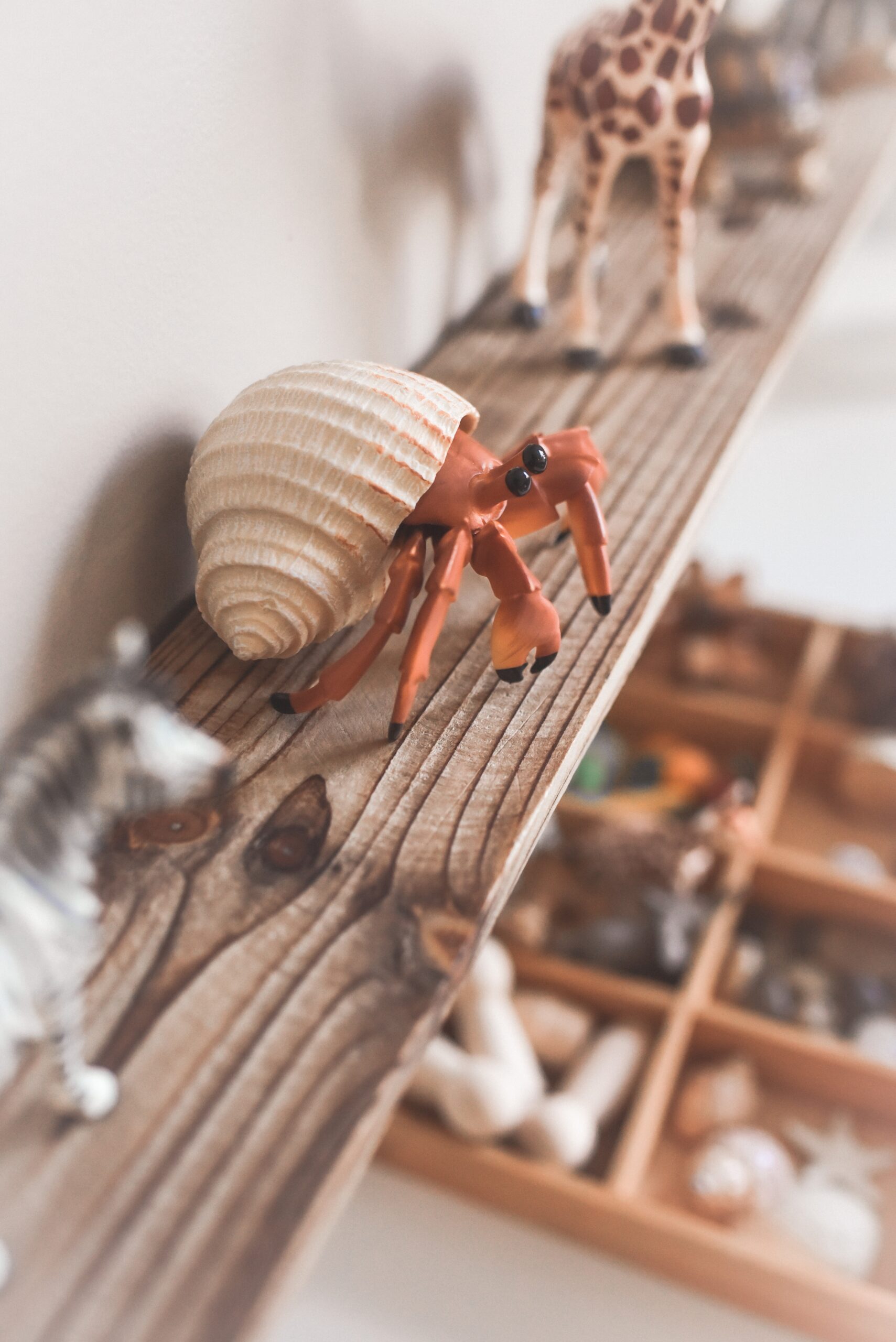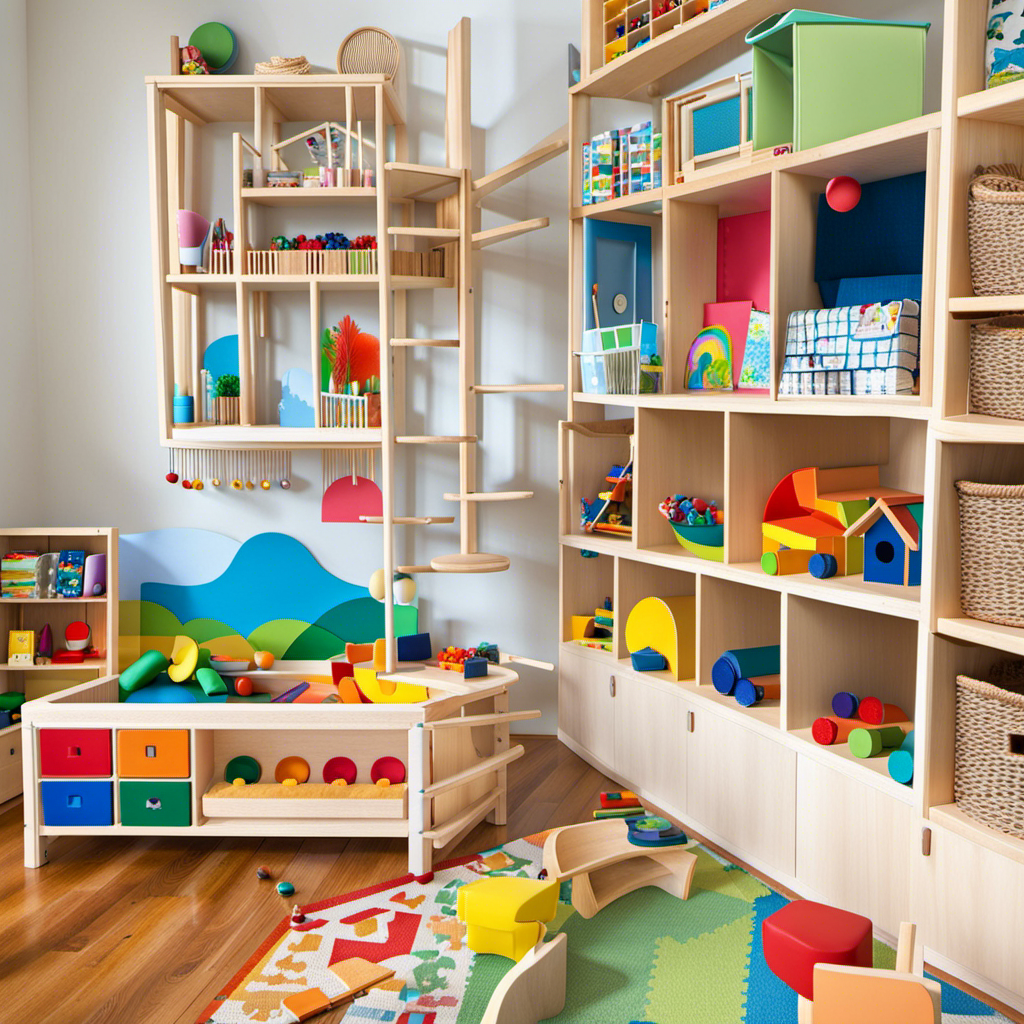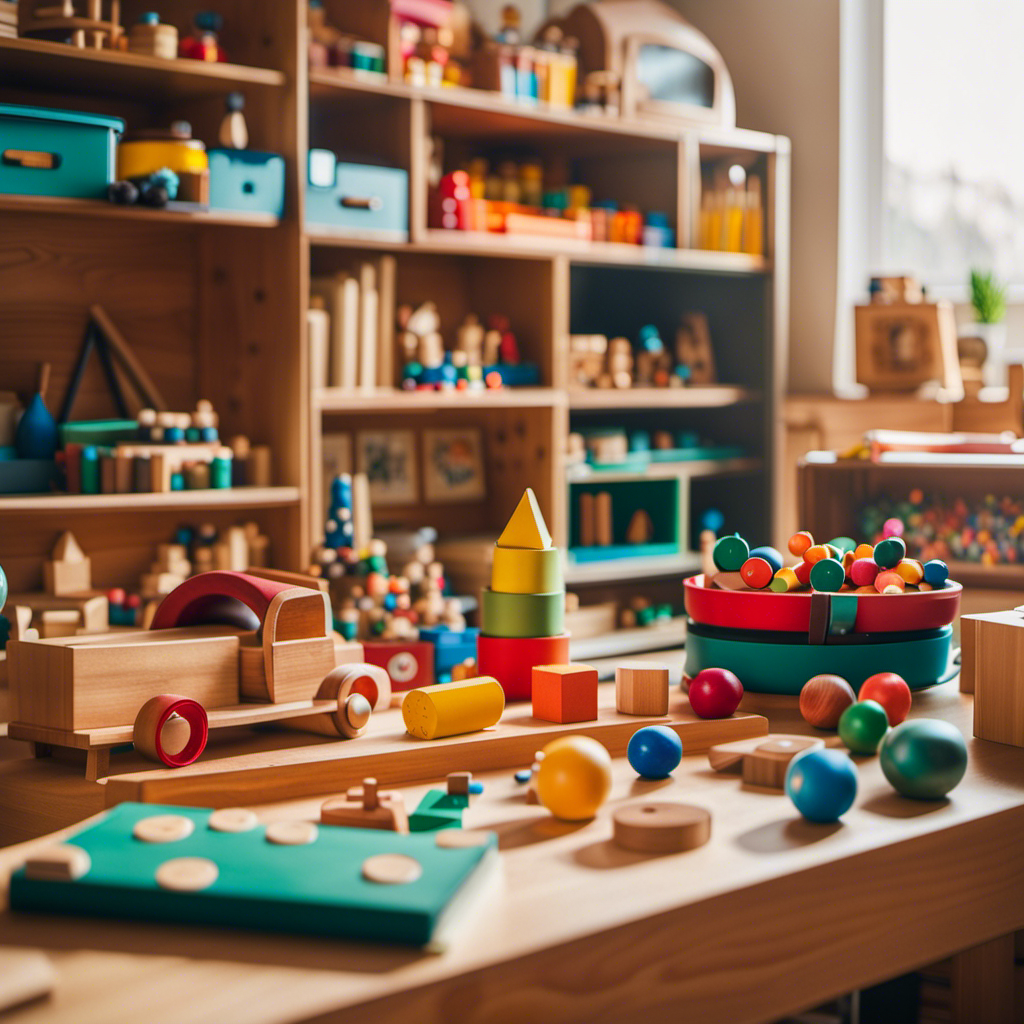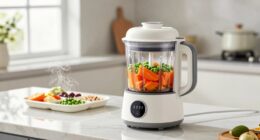I discovered a new approach that has changed how I organize my toddler’s toys: the Montessori method.
By implementing Montessori principles, I’ve witnessed firsthand the benefits of a well-organized toy system that promotes independent play and skill development.
In this article, I will share research-based strategies for choosing the right storage solutions, sorting and categorizing toys, and creating a rotating toy system.
Get ready to transform your playroom into a Montessori haven that maximizes learning and minimizes clutter.
Key Takeaways
- Montessori toy organization promotes independence, responsibility, creativity, and cognitive development.
- Choosing the right storage solutions such as open shelving units, clear bins with labels, wall-mounted storage, or rolling carts creates an organized and accessible environment.
- Sorting and categorizing Montessori toys based on skill development enhances targeted learning opportunities and supports fine motor and cognitive development.
- Creating a rotating toy system in Montessori playrooms keeps the play area organized, promotes focused play and concentration, and exposes children to different play experiences.
Benefits of Montessori Toy Organization for Toddlers
You’ll love the benefits of Montessori toy organization for your toddler. Organized play not only helps keep your home tidy, but it also has numerous advantages for your child’s development.
One of the main benefits is that it promotes independence. When toys are neatly organized and easily accessible, your toddler can choose what they want to play with and learn how to clean up after themselves. This fosters a sense of responsibility and self-sufficiency.
Additionally, organized play encourages creativity and imagination. By having a designated place for each toy, your child can easily find what they need and explore different play possibilities. It also helps develop their cognitive skills, as they learn to categorize and sort their toys.
Now, let’s move on to choosing the right storage solutions for Montessori toys, ensuring an effective and efficient organization system.
Choosing the Right Storage Solutions for Montessori Toys
When choosing the right storage solutions for Montessori toys, it’s important to consider accessibility and organization. As a parent, I understand the struggle of keeping my toddler’s toy collection organized and easily accessible. Here are some toy storage options that can help make your life easier:
-
Open shelving units: These allow for easy visibility and access to toys, promoting independence and self-directed play.
-
Clear bins with labels: Labeling bins with pictures or words can help toddlers learn to categorize and clean up their toys.
-
Wall-mounted storage: Utilizing wall space can free up valuable floor space and keep toys within reach.
-
Rolling carts or baskets: These portable storage options make it easy to move toys from room to room for playtime and cleanup.
By considering these toy storage options, you can create an organized and accessible environment for your child’s Montessori toy collection.
Now, let’s explore how sorting and categorizing Montessori toys by skill development can further enhance their learning experience.
Sorting and Categorizing Montessori Toys by Skill Development
To enhance your child’s learning experience, consider sorting and categorizing Montessori toys based on their skill development. This approach allows you to provide targeted learning opportunities that support your child’s fine motor and cognitive development. By organizing toys into specific categories, you can easily identify which skills each toy promotes and strategically incorporate them into your child’s playtime.
Here is a table that illustrates how you can sort Montessori toys based on their skill development:
| Skill Development | Examples of Toys |
|---|---|
| Fine Motor Skills | Wooden puzzles, stringing beads, stacking blocks |
| Cognitive Development | Shape sorters, matching games, memory cards |
By implementing this sorting and categorizing system, you can ensure that your child engages with a variety of toys that target different areas of development. This approach fosters a well-rounded learning experience and supports your child’s overall growth.
Now, let’s explore how you can create a rotating toy system for Montessori playrooms, ensuring that your child always has access to new and engaging toys.
Creating a Rotating Toy System for Montessori Playrooms
Creating a rotating toy system in Montessori playrooms ensures that children have access to a constant variety of engaging and new toys.
Montessori toy rotation is a technique where a limited number of toys are displayed and made available to children at a time, while the remaining toys are stored away.
This method not only helps in keeping the play area organized and clutter-free but also promotes focused play and concentration in children.
The key to successful toy rotation is to carefully select toys based on their developmental appropriateness and learning potential.
By regularly rotating toys, children are exposed to different types of play experiences, fostering their imagination, creativity, and cognitive skills.
Moreover, toy rotation encourages independence and responsibility in children, as they learn to take care of their toys and keep them organized.
Incorporating Montessori Principles in Toy Display and Accessibility
As a parent, I have found that incorporating Montessori principles in toy display and accessibility has been incredibly beneficial for my child’s development.
One key aspect of this approach is child-led toy organization, where children are encouraged to participate in the process of tidying up and deciding where toys should be placed. This not only teaches them responsibility but also allows them to have a sense of ownership over their environment.
Additionally, having open shelves instead of closed toy boxes has numerous benefits, such as promoting independence, fostering creativity, and making it easier for children to see and access their toys.
Lastly, rotating the toy selection on a regular basis keeps things fresh and exciting for children, encourages exploration, and prevents them from becoming overwhelmed with too many options at once.
Child-Led Toy Organization
Let your toddler take the lead in organizing their toys the Montessori way. Child-led toy organization allows children to develop independence, decision-making skills, and a sense of ownership over their belongings.
Here are two key benefits of implementing child-led toy rotation and organizing toys by developmental stage:
-
Encourages autonomy: Allowing your child to choose which toys to play with and where to store them promotes independence and decision-making skills. They learn to take responsibility for their belongings and develop a sense of ownership.
-
Supports development: Organizing toys by developmental stage ensures that your child has access to toys that are appropriate for their current abilities and interests. This encourages their physical, cognitive, and social-emotional development.
Open Shelves Benefits
When using open shelves, you can easily display and access your child’s toys, making it convenient for them to choose what they want to play with. Open shelving provides several benefits when it comes to organizing toddler toys in a Montessori-inspired way. First, it promotes independence and autonomy by allowing children to see and select their toys without adult intervention. Second, it encourages visual organization and categorization skills as children learn to place toys in designated spots on the shelves. Lastly, open shelves create a visually appealing and inviting play area that helps stimulate a child’s imagination and creativity.
| Benefits of Open Shelving |
|---|
| Promotes Independence |
| Develops Organization Skills |
| Stimulates Imagination |
Rotating Toy Selection
By implementing a rotating toy selection, you can keep your child’s play area fresh and exciting, stimulating their creativity and imagination. Maximizing playtime is essential for a toddler’s development, and toy rotation strategies can help achieve this goal.
Here are three benefits of implementing a rotating toy selection:
-
Avoiding boredom: When toys are rotated regularly, it prevents children from getting bored with the same toys. By introducing new toys, children are more engaged and eager to explore, leading to longer and more productive play sessions.
-
Stimulating creativity: A rotating toy selection encourages children to think creatively and find new ways to play with different toys. It promotes problem-solving skills and imaginative thinking, as they have to adapt and create new scenarios with the toys available.
-
Enhancing focus and attention span: By limiting the number of toys available at a given time, children are less overwhelmed and can focus better on each toy. This helps improve their attention span and ability to concentrate on one activity for longer periods.
Transition: In addition to implementing a rotating toy selection, establishing a daily toy cleanup routine for toddlers is equally important in maintaining an organized and clutter-free play area.
Establishing a Daily Toy Cleanup Routine for Toddlers
One way to establish a daily toy cleanup routine for toddlers is to involve them in the process. By teaching them the importance of keeping their toys organized and clean, they will develop valuable life skills and habits.
Start by designating specific toy bins or containers for different types of toys, such as blocks, stuffed animals, or puzzles. Labeling these bins with pictures or words can help toddlers understand where each toy belongs.
Encourage your toddler to participate in the cleanup routine by making it a fun and interactive activity. Singing a cleanup song or playing a cleanup game can make the process more enjoyable for them. Additionally, providing clear and consistent instructions will help toddlers understand the expectations.
By involving toddlers in the daily toy cleanup routine, they will learn responsibility and develop a sense of ownership over their toys.
Transitioning into implementing minimalist toy organization in Montessori spaces, it is important to create an environment that promotes simplicity and fosters independence for toddlers.
Implementing Minimalist Toy Organization in Montessori Spaces
Implementing a minimalist approach to toy organization in Montessori spaces can create an environment that fosters simplicity and independence for young children. By reducing clutter and organizing play materials in a purposeful manner, children are better able to engage in meaningful play and develop important skills. A minimalist toy display allows for easier access to toys, promotes focus and concentration, and encourages children to take responsibility for their belongings. To illustrate the benefits of minimalist toy organization, consider the following table:
| Benefits of Minimalist Toy Organization |
|---|
| 1. Reduces visual distractions |
| 2. Encourages independent play |
| 3. Promotes creativity and imagination |
| 4. Develops critical thinking skills |
DIY Toy Labels and Labels in Montessori Toy Organization
To enhance the organization and accessibility of your play materials, consider creating your own DIY toy labels and incorporating labels into your toy organization system.
DIY toy labels can be a fun and creative way to personalize your toy storage and make it more visually appealing for your child. You can use a variety of materials such as cardstock, adhesive labels, or even chalkboard paint to create your labels.
When organizing small toys, it’s helpful to categorize them by type or theme. For example, you can have separate labels for blocks, puzzles, cars, and dolls. By labeling each toy category, you not only make it easier for your child to find and put away their toys, but you also teach them valuable organizational skills.
Transitioning into the next section about utilizing open shelving for Montessori toy storage, incorporating DIY toy labels on the shelves can further enhance the organization and aesthetic appeal of the space.
Utilizing Open Shelving for Montessori Toy Storage
When using open shelving for toy storage in a Montessori-inspired space, it’s important to create a visually inviting and accessible environment for your child. Open shelving offers several benefits in terms of child-led toy organization. Firstly, it allows for easy visibility and access to toys, enabling children to independently choose and return toys during playtime. Secondly, open shelving promotes organization skills as children can clearly see where each toy belongs. Lastly, it encourages creativity and imagination as toys are displayed in an aesthetically pleasing manner, inspiring children to engage in open-ended play. To illustrate the benefits of open shelving, here is a table showcasing the advantages:
| Open Shelving Benefits |
|---|
| Easy visibility and access to toys |
| Promotes organization skills |
| Encourages creativity and imagination |
Montessori Toy Rotation Strategies for Maximizing Play and Learning
By rotating toys in a Montessori-inspired space, we can enhance play and learning experiences for children. Maximizing playtime is crucial for a child’s development, and a carefully curated selection of educational toys can greatly contribute to this goal.
According to research, rotating toys in a Montessori environment helps prevent overstimulation and keeps children engaged and focused on the toys at hand. By limiting the number of toys available at a given time, children can fully explore and master each toy before moving on to the next. This approach encourages concentration, problem-solving skills, and creativity.
Furthermore, rotating toys allows for variety and novelty, keeping children excited and interested in their playtime.
As we explore the next section on encouraging independence in toddlers through self-service toy areas, we’ll see how these principles align with Montessori philosophy.
Encouraging Independence in Toddlers Through Self-Service Toy Areas
You can foster independence in your little one by creating self-service areas for their toys. This not only encourages independent play but also teaches them important life skills. Here are three ways to create self-service toy areas that promote independent play and toy accessibility:
-
Organize toys in open shelves or bins: Make sure toys are easily visible and accessible to your child. Use open shelves or clear bins so they can easily see and choose the toys they want to play with.
-
Use picture labels: Attach picture labels to the shelves or bins to help your child identify and locate their toys. This promotes literacy development and enhances their ability to independently find and put away toys.
-
Establish a routine: Set a regular time for your child to engage in independent play and encourage them to choose toys from their self-service area during this time. This helps them develop a sense of ownership and responsibility for their toys.
Managing Toy Clutter and Overwhelm in Montessori Environments
When it comes to managing toy clutter and overwhelm in Montessori environments, two key strategies that have been proven effective are simplifying the play space and implementing a rotating toy selection.
Simplifying the play space involves decluttering and organizing the toys in a way that promotes exploration and independence. This can be achieved by having clear and designated areas for different types of toys, such as a shelf for puzzles and a bin for building blocks.
Additionally, rotating the toy selection helps to keep the play space fresh and engaging, as well as prevent children from becoming overwhelmed by too many toys at once.
Simplifying Play Space
To simplify your play space, start by decluttering and organizing your toddler’s toys using Montessori principles.
Simplified toy rotation is a key aspect of the Montessori approach to play. Instead of overwhelming your child with a large number of toys, a minimalist playroom setup focuses on a carefully curated selection of toys that promote learning and development.
Begin by assessing your current toy collection and removing any toys that are broken, unsafe, or no longer age-appropriate. Next, categorize the remaining toys into different learning areas, such as sensory play, fine motor skills, or imaginative play. Store each category in separate bins or shelves, making it easier for your child to access and clean up.
By simplifying your play space, you create a more inviting and organized environment for your toddler to explore and learn.
As we transition into the next section about rotating toy selection, consider how regularly switching out toys can keep your child engaged and prevent boredom.
Rotating Toy Selection
Instead of overwhelming your child with too many toys, try regularly switching out their toy selection to keep them engaged and prevent boredom. Here are four reasons why rotating toy selection is beneficial for maximizing playtime and organizing play spaces:
-
Increased engagement: When children have access to a smaller number of toys, they are more likely to fully explore and engage with each one, leading to longer periods of focused play.
-
Enhanced creativity: By limiting the number of toys available at any given time, children are encouraged to use their imagination and find new ways to play with their existing toys.
-
Reduced clutter: Regularly rotating toys helps to minimize the amount of clutter in play spaces, creating a more organized and visually appealing environment for both children and parents.
-
Novelty factor: Introducing new toys into the rotation can help sustain a child’s interest and excitement in playtime, preventing them from becoming bored or disinterested.
Sustaining Montessori Toy Organization Systems for Long-Term Success
You can maintain long-term success with your Montessori toy organization systems by implementing sustainable practices.
One way to achieve this is by creating a minimalist toy collection. Start by decluttering your toy storage spaces and selecting toys that promote open-ended play and skill development. Consider the quality and durability of the toys, as well as their ability to engage your child’s imagination. Toys that have multiple uses and can be easily integrated into different activities are ideal.
Additionally, prioritize toys that are made from sustainable materials, such as wood or organic cotton. These eco-friendly options not only benefit the environment but also provide a healthier play environment for your child.
Frequently Asked Questions
How Do I Choose the Right Storage Solutions for Montessori Toys?
When it comes to choosing the right storage solutions for Montessori toys, it’s important to consider functionality and organization.
You want to create a clutter-free play area for your toddler, which means finding storage options that are easy to access and maintain.
Look for open shelves or baskets that allow your child to see and choose their toys independently.
Utilize labels or picture labels to help with clean up and teaching them where each toy belongs.
How Can I Incorporate Montessori Principles in Toy Display and Accessibility?
When it comes to incorporating Montessori principles in toy rotation and creating a Montessori inspired play space, there are a few key things to keep in mind.
First, make sure to have a variety of toys that promote exploration and learning.
Second, organize the toys in a way that allows for easy accessibility and encourages independent play.
Lastly, regularly rotate the toys to keep your little one engaged and excited.
What Are Some DIY Toy Labels and Labels in Montessori Toy Organization?
When it comes to organizing toddler toys in a Montessori style, DIY toy storage and labeling are key.
DIY toy labels can be a fun and creative way to make toy organization more accessible for your child.
Not only do they help with categorizing and tidying up, but they also promote independence and decision-making skills.
How Can I Utilize Open Shelving for Montessori Toy Storage?
I recently discovered the benefits of utilizing open shelving for organizing my toddler’s toys in a Montessori-inspired way. By using open shelves, my child can easily see and access their toys, promoting independence and self-directed play. It also encourages them to take responsibility for cleaning up after themselves.
However, if open shelving doesn’t work for your space or preferences, there are alternative options such as labeled bins or baskets that can still promote organization and a Montessori approach to toy storage.
How Do I Sustain Montessori Toy Organization Systems for Long-Term Success?
To sustain Montessori toy organization systems for long-term success, it’s crucial to prioritize the principles of the Montessori method. This includes creating an environment that promotes independence, order, and self-discipline.
By providing open shelving and clear containers, children can easily see and access their toys. Regularly rotating toys and involving children in the organization process can help maintain their interest and engagement.
Consistency and regular decluttering are also key to ensuring a successful and sustainable Montessori toy organization system.
Conclusion
In conclusion, organizing toddler toys in a Montessori style can have numerous benefits for your child’s development. By choosing the right storage solutions and sorting and categorizing toys by skill development, you can create an environment that promotes independent play and learning.
Creating a rotating toy system and incorporating Montessori principles in toy display and accessibility can further enhance your toddler’s independence and problem-solving skills. Additionally, encouraging self-service toy areas can empower your child to take ownership of their playtime.
Managing toy clutter and overwhelm is crucial to sustaining Montessori toy organization systems. By doing so, you can create a long-term successful environment that promotes optimal play and learning for your child.
